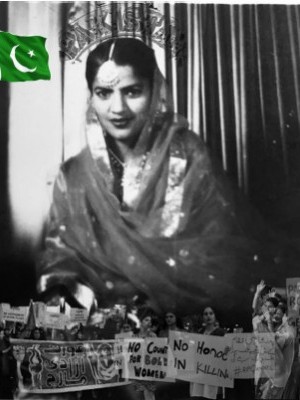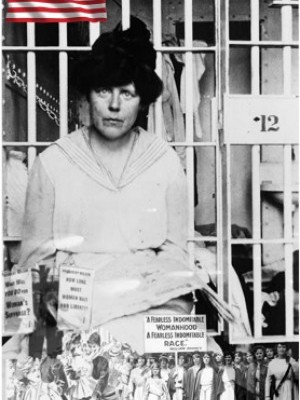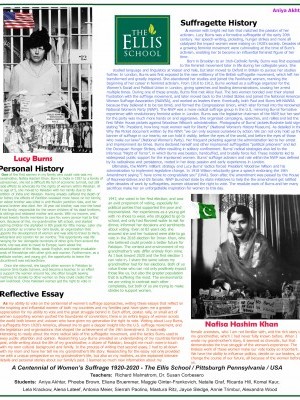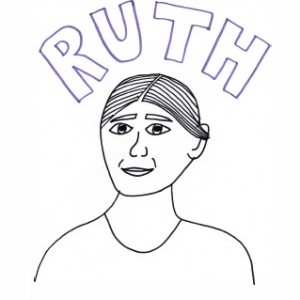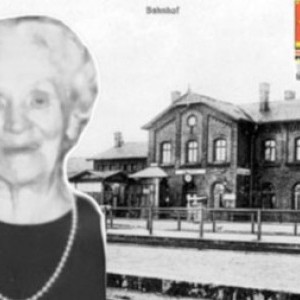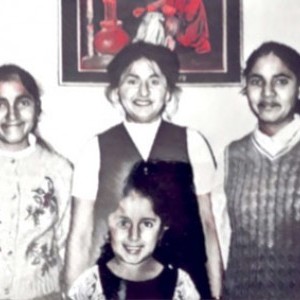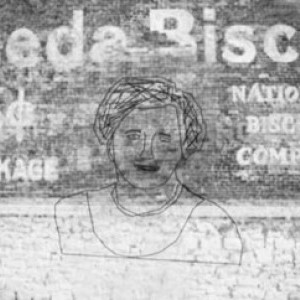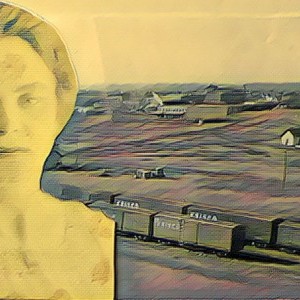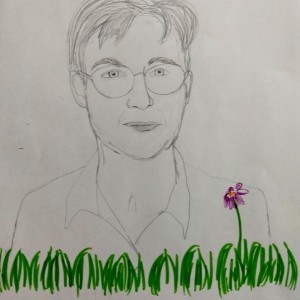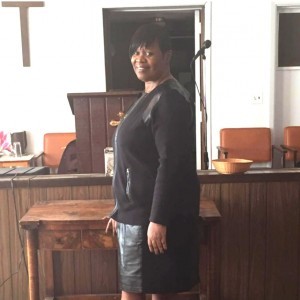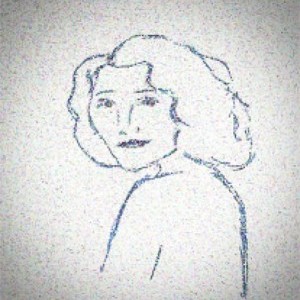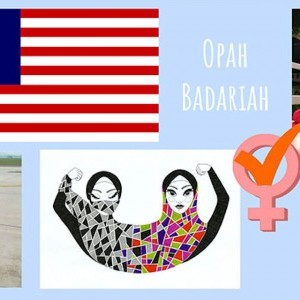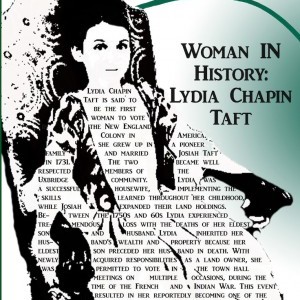Aniya Ahktar
The Ellis School | Pittsburgh, PA | 11th Grade
Inspirational Family Member
My Grandmother
One of the first women in my family who could vote was my grandmother, Nafisa Hashim Khan. Born in India in 1937 to a family of businessmen, she led a difficult life full of economic turmoil, but still made efforts to advocate for the rights of women within Pakistan. At the age of 5, she moved to Pakistan with her family due to the Partition of India and Pakistan. Having already suffered the death of her father, the effects of Partition wreaked more havoc on her family; her eldest brother was killed in anti-Muslim partition riots, and her second brother also died.
Her 18 year-old brother was now the head of the family, responsible for the seven children of his dead brothers, his siblings and widowed mother and aunts. With no income, and almost ten family members to care for, every person had to find work. Because of this, my grandmother left school, and started teaching children the alphabet in 8th grade for little money. Later she got a position as a trainer for Girls Guide, an organization that supports the development of women, and was able to travel to Paris, Switzerland and London for six months. This opportunity was life changing for her. Alongside hundreds of other girls from around the world, she was able to travel to Europe, learn about the industrialization of the West, speak English, and create invaluable bonds of friendships with other girls and women. Furthermore, as a destitute orphan, and young girl, the opportunity to leave the subcontinent was extraordinary.
Once she returned, she taught other women in Pakistan to become Girls Guide trainers, and became a teacher. In an effort to support the women around her, she often bought sewing machines to donate to other women so they could create their own livelihood. Once Pakistani women got the right to vote in 1947, she voted in her first election, and was an avid proponent of voting, especially for political parties that supported the poor and impoverished. Her experiences as a young girl with no shoes to wear who struggled to go to school, and only had flavored water to eat for dinner, informed her decisions and sentiments about voting. Even at 82 years old, she ensured she and her husband were able to go vote in the 2018 election for Imran Khan, who she believed could provide a better future for Pakistan.
The context and environment of my grandmother’s vote differ entirely from mine. As I look toward 2020 and the first election I can vote in, I share the same values my grandmother had for her elections. Both of us value those who can not only positively impact those like us, but also the greater population that is suffering the most. The environments we are voting in contrast each other completely, but both of us are trying to make strides to support women.
Historical Figure I Admire
Lucy Burns
A woman with bright red hair that matched the passion of her activism and fierceness, Lucy Burns was a formative suffragette of the early 20th century. Her speech-writing, picketing, hunger strikes and more all catalyzed the impact women were making on 1920’s society. Decades of a growing feminist movement was culminating at the time of Burns' activism, enabling her to become an influential feminist figure of her time. Burns' radical tactics, passion and leadership within the National Women’s Party made her a significant contributor to the suffragette movement.
Born in Brooklyn to an Irish-Catholic family, Burns was first exposed to the feminist movement later in life during her collegiate years. She first studied language and linguistics at Vassar and Yale, but later moved to Oxford in London to pursue her studies further. In London, Burns was first exposed to the new militarism of the British suffragette movement, which left her transformed and greatly inspired. She abandoned her studies and joined the Pankhurst women, marking the beginning of her career in feminist activism. From 1910 to 1912, Burns worked as a suffrage organizer for the Women’s Social and Political Union in London, giving speeches and leading demonstrations, causing her arrest multiple times. During one of these arrests, Burns first met Alice Paul. The two women bonded over their shared frustration with the suffrage movement, and later moved back to the United States and joined the National American Woman Suffrage Association (NAWSA), and worked as leaders there. Eventually, Paul and Burns both left NAWSA and formed the Congressional Union, which later formed into the renowned National Woman’s Party (NWP). The NWP was a more radical suffrage group in the U.S, mirroring Burns’ formative experience with revolutionary feminist action in London. Burns was the legislative chairman of the NWP, but her work for the party was much more hands on and aggressive. She organized campaigns, speeches, and rallies and led the first White House pickets against Woodrow Wilson’s administration. Photographs of Burns’ pickets illustrate bold signs stating “Mr. President, how long must women wait for liberty?” (National Women’s History Museum). As detailed in the "Why We Picket" document written by the NWP, “we can only express ourselves by action. We can not only hold up the banner of suffrage in our hearts; we can hold it visibly, before the eyes of the world, and before the eyes of those who make our laws” (National Woman’s Party). Her frequent picketing against the administration led to her arrest and imprisonment six times. Burns declared herself and other imprisoned suffragettes “political prisoners” and led the Occoquan Hunger Strikes, often resulting in solitary confinement. Burns’ radical strategies also led to the infamous “Night of Terror”, in which Burns was beaten, handcuffed, and brutally force fed. These incidents led to widespread public support for the imprisoned women. Burns’ suffrage activism and role within the NWP was defined by its radicalness and persistence, rooted in her deep passion and early experiences in London.
Ultimately, the NWP’s militant strategy and Lucy Burns’ tactics forced President Woodrow Wilson and his administration to implement legislative change within the government. Wilson reluctantly gave a speech endorsing the 19th Amendment and saying “I have come to congratulate you” (UVA) in 1918. Soon after, the amendment was passed by the House of Representatives and the US Senate. NWP launched state by state initiatives to help the amendment get ratified, and after tireless work by numerous suffragettes, women obtained the right to vote. The resolute work of Lucy Burns and her many physical sacrifices pushed the 19th Amendment to passing and made her an inspiration to women of the 20th and 21st century.
SOURCES +
What the Project Means to Me
As my ability to vote on the centennial of women’s suffrage approaches, writing these essays that reflect on the inspiring and influential women of both my countries and my families past have given me a greater appreciation for my ability to vote and the great struggle behind it. Each effort, poster, rally, or small act of women supporting women pushed the boundaries of convention; there is an entire legacy of women across the world both known and unknown who have given my generation the right to vote. Writing about Lucy Burns, a suffragette from 1920’s America, allowed me to gain a deeper insight into the U.S. suffrage movement, and the legislation and organizations that shaped the achievement of the 19th Amendment. It was really interesting to ready about the more radical side of the suffragette movement, and the tactics Burns used to sway public attention and opinion.
Researching Lucy Burns provided an understanding of my country’s feminist past, while writing about the life of my grandmother, a citizen of Pakistan, brought me much more in touch with my own cultural background and family. In the process of writing that second essay, I had to sit down with my mom and have her tell me my grandmother’s life story. Researching for the essay not only provided me with a unique perspective on my grandmother’s life, but also on my mother’s, as she explained intimate details and personal stories about our family’s past. I learned so much new information about my female ancestors, who I am not familiar with, and the rich story of my grandmother, which I had never fully known before. When I wrote my grandmother’s story, it seemed so dramatic, but that demonstrates the true struggle of the woman’s experience. The tireless work of these women make our vote today so important. We have the ability to influence politics, decide on our leaders, and change the course of our future, all because of the women before us.
Explore the Archive
More From This Class
Click on the thumbnails below to view each student's work.Deadline Extended
There's still time to join Women Leading the Way.
Become a part of our storytelling archive. Enroll your class today.
Join the Project

